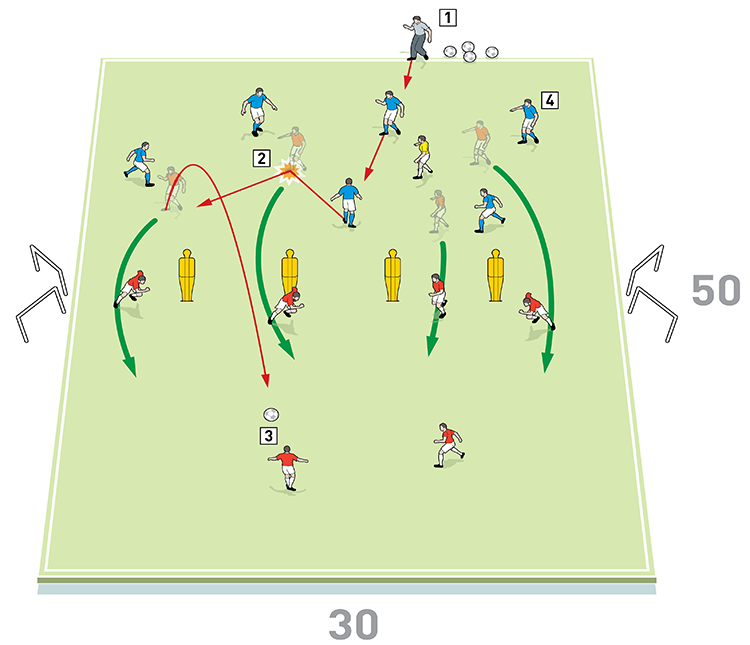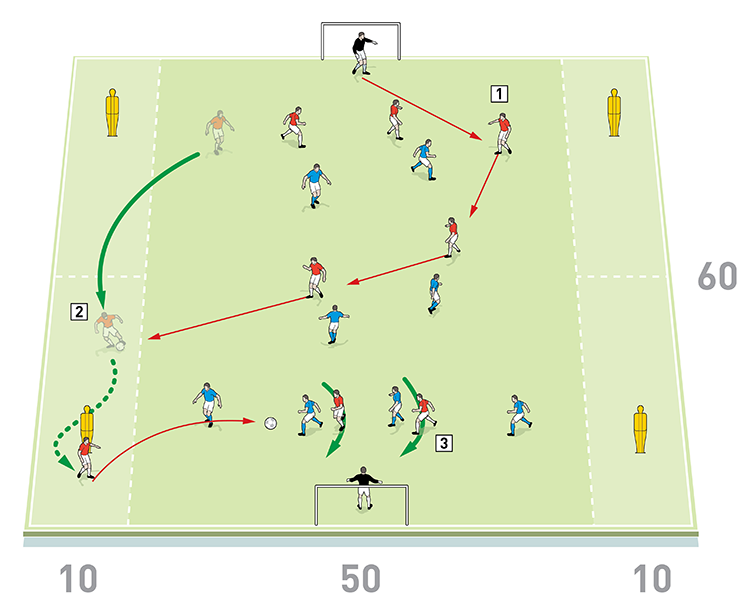Switching the point of attack
Encourage your players to switch the point of attack at pace – get the ball into wide areas of the pitch and enable the wingers to cross into the runs of the attackers.

| Area | Up to 60x70 yards |
| Equipment | Balls, bibs, cones, 4 mannequins, 4 mini target goals, 2 full size goals |
| No. of Players | Up to 16 players + 2 goalkeepers |
| Session Time | Warm-up: 10mins, Switch play: 15mins, Switching to cross: 15mins, Runs to attack cross: 15mins, Conditioned game: 20mins |
This is all about encouraging players to switch the point of attack at pace. We would run this if we were playing against a team with narrow support, such as a narrow back three and a diamond midfield. The idea behind the session is to get the ball into wide areas of the pitch, enabling teams to cross into the runs of the attackers.
As we like to get the tempo of the session as high as possible straight from the start, we warm up with an intense possession practice. The session then progresses through a series of activities that will make players think about switching the point of attack at speed and making supporting runs into the penalty area to meet crosses delivered from the wide channels.
What do I get the players to do?
Warm-up
We set up a hexagon-shaped area with each of its six sides measuring seven yards in length. We’re using 10 players, split into two teams of five. Three players from each team are positioned on the outside edges of the hexagon, leaving two players from each team in the centre, as shown [1].
One team passes under pressure, with the inside players linking up with their team mates on the outside to keep hold of the ball, creating a 5v2 in favour of the team in possession.
We can progress the warm-up by increasing the dimensions of the hexagon to eight yards on each side and by adding a player to each team, making it 3v3 in the centre.
We rotate players every minute, giving everyone the opportunity to play in the centre of the hexagon.
1

2. The reds can use their team mates on the outside to help them keep the ball, making it 5v2 when in possession
3. The blues in the centre press and try to win possession
Switch play
We set up an area of 50x30 yards with a row of mannequins between the two halves. Two target goals are positioned at an angle on each side of the pitch, level with the mannequins. We’re using 13 players divided into two teams of six, plus a floater.
The possession team starts with all of their players in one half, while their opponents have four players in that half and two players in the other half. The possession team links with the floater to keep hold of the ball and they must make at least four passes before attempting to score in one of the target goals, as shown [2a].
2a

2. The blues link up with the yellow floater to switch the ball from side to side at pace
3. The possession team must make four passes before scoring in a target goal. If they score they keep possession and switch the play again to score in the other goal
4. The four reds press the possession team and try to win the ball
If they score in one goal, the coach serves another ball to the possession team and they continue to pass, switching the play to the other side of the same half so they can score in the second goal.
The defending team attempts to win the ball and if successful, they must quickly switch the play to their two team mates in the other half by passing through the mannequins, as shown [2b]. The four pressers then join their team mates in the other half, along with the floater. Four of their opponents also change ends, creating a new 7v4 in the other half. They are now the new possession team and together with the floater they should pass the ball under pressure and try to score in one of the mini goals.
It is important for the success of the activity that teams switch the play from side to side with pace.
2b

2. The reds win the ball and quickly switch the play by passing through the mannequins to their team mates in the other half
3. The four reds and the floater follow the ball into the other half and become the new possession team. Play continues with the reds now trying to score
4. Four of the six blues should also follow the ball into the other half to become the new pressing team
Switching to cross
This activity is all about switching the point of attack and scoring from a cross.
We set up an area of 60x40 yards with a 20x20-yard box marked out in the centre and a full size goal and goalkeeper at each end. Four mannequins are positioned as shown [3].
We’re using 15 outfield players, split into two teams of seven and one floater, who plays for the team in possession. It’s 5v5 plus the floater in the central box and each team has two unopposed wingers outside the box in the half they are attacking.
The team in possession must make six passes incorporating a switch of play and then pass to one of the wide players outside the box. On receiving the pass, the wide player dribbles past the mannequin, while two attackers make runs out of the central box to attack the cross.
If the possession team scores from the cross, they restart with the ball. If they don’t score, the other team gains possession with a starting pass into the central box from their goalkeeper.
3

2. The blues press the ball and try to gain possession
3. After six passes the reds can pass out to the winger, who dribbles past the mannequin to cross
4. The pass to the wide man triggers two attackers to break out of the central box. If they score they keep possession when play restarts again
Runs to attack cross
We set up on half a pitch, with a goal and a goalkeeper at one end. We’re using four outfield players for this crossing drill, set up as shown [4].
Player 1 starts with a pass to player 2 and then makes an overlapping run into the wide channel. Player 2 receives and passes to either player 3 or player 4, who combine to work the ball out to player 1 in the wide channel. Player 1 crosses and players 2, 3 and 4 make runs into the penalty area to attack the cross.
Repeat the drill on the left so crosses come from both sides of the pitch.
4

2. Player 2 passes to either player 3 or 4, who combine to work the ball to player 1 on the wing
3. Player 1 crosses into the penalty area
4. Players 2, 3 and 4 make runs to attack the cross and try to score
How would you put this into a game situation?
Conditioned game
We set up an area of 60x50 yards with additional 10-yard wide channels on either side and a goal and goalkeeper at each end. Four mannequins are set up in the wide channels, as shown [5]. We’re using 16 outfield players in an 8v8 game.
The players are encouraged to pass the ball into the unopposed wide channels as quickly as possible. Only one wide player can go into the channel to receive the ball and he must beat the mannequin and cross into the box, where his team mates attempt to score.
5

2. One wide player can go into the unopposed wide channel to receive the pass. He then beats the mannequin and crosses
3. The forwards attack the cross and attempt to score
Editor's Picks
Attacking transitions
Deep runs in the final third
Using the goalkeeper in build-up play
Intensive boxes drill with goals
Penetrating the final third
Creating and finishing
My philosophy
Pressing initiation
Compact team movement
Coaches' Testimonials

Alan Pardew

Arsène Wenger

Brendan Rodgers

Carlos Carvalhal

José Mourinho

Jürgen Klopp

Pep Guardiola

Roy Hodgson

Sir Alex Ferguson

Steven Gerrard
Coaches' Testimonials

Gerald Kearney, Downtown Las Vegas Soccer Club

Paul Butler, Florida, USA

Rick Shields, Springboro, USA

Tony Green, Pierrefonds Titans, Quebec, Canada
Join the world's leading coaches and managers and discover for yourself one of the best kept secrets in coaching. No other training tool on the planet is written or read by the calibre of names you’ll find in Elite Soccer.
In a recent survey 92% of subscribers said Elite Soccer makes them more confident, 89% said it makes them a more effective coach and 91% said it makes them more inspired.
Get Monthly Inspiration
All the latest techniques and approaches
Since 2010 Elite Soccer has given subscribers exclusive insight into the training ground practices of the world’s best coaches. Published in partnership with the League Managers Association we have unparalleled access to the leading lights in the English leagues, as well as a host of international managers.
Elite Soccer exclusively features sessions written by the coaches themselves. There are no observed sessions and no sessions “in the style of”, just first-hand advice delivered direct to you from the coach.









